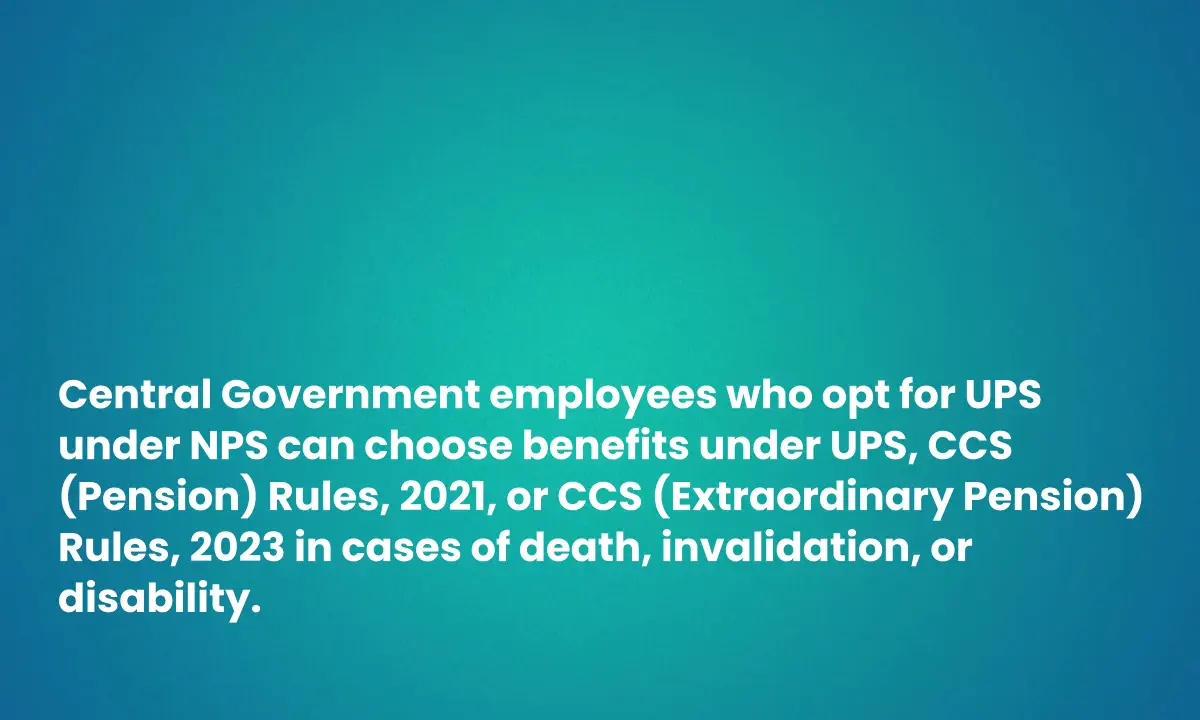Central Government Rolls Out Flexible Pension Choices Under UPS

On June 18, 2025, the Government of India introduced a significant update to its pension framework, offering Central Government employees covered under the Unified Pension Scheme (UPS) new options to secure their financial future. The Ministry of Personnel, Public Grievances, and Pensions issued an Office Memorandum (No. 57/01/2025-P&PW(B)/UPS/10498) that allows employees to choose between benefits under the UPS, the CCS (Pension) Rules, 2021, or the CCS (Extraordinary Pension) Rules, 2023 in cases of death during service, invalidation, or disability. This move aims to provide greater flexibility and security for government servants and their families.
What is the Unified Pension Scheme?
The Unified Pension Scheme, introduced via a Ministry of Finance notification on January 24, 2025, is an optional pension plan under the National Pension System (NPS) for Central Government employees recruited on or after April 1, 2025. Employees under NPS can opt for UPS, which now includes the ability to choose alternative pension benefits in specific circumstances. This update builds on the CCS (Implementation of National Pension System) Rules, 2021, particularly Rule 10, which governs pension options for NPS-covered employees.
Key Highlights of the New Pension Options
The memorandum outlines a structured process for employees to exercise their pension choices, ensuring clarity and transparency. Here’s what you need to know:
- Eligibility: Central Government employees who opt for UPS under NPS can choose benefits under UPS, CCS (Pension) Rules, 2021, or CCS (Extraordinary Pension) Rules, 2023 in cases of death, invalidation, or disability.
- Option Submission: Employees must submit their choice via Form 1 at the time of joining service. Existing employees who have opted for UPS must exercise this option promptly after the notification.
- Family Details: Employees must provide family details in Form 2, which the Head of Office will verify and record in the service book.
- Flexibility to Revise: Employees can revise their pension option multiple times before retirement by notifying the Head of Office.
- Default Options: If no option is exercised and an employee dies or is discharged before completing 15 years of service, benefits default to CCS (Pension) Rules, 2021, or CCS (Extraordinary Pension) Rules, 2023.
How Does the Process Work?
The process is designed to be straightforward, with clear roles for employees and administrative officers:
- Employee Action: New joinees submit Form 1 to select their preferred pension benefits and Form 2 to declare family details. Existing employees must submit these forms soon after the notification.
- Head of Office Role: The Head of Office verifies the forms, records them in the employee’s service book, and forwards copies to the Central Recordkeeping Agency via the Drawing and Disbursing Officer and Pay and Accounts Officer.
- Recordkeeping: The Pay and Accounts Officer enters the option details into an online system for tracking.
- Updates: Employees can update family details or revise pension options as needed, with changes documented in Form 2.
Special Provisions for Death or Disability
The memorandum addresses specific scenarios to ensure employees and their families are protected:
- Death During Service: The last option exercised by the deceased employee is final, and the family cannot revise it. If no option was chosen and the employee had less than 15 years of service, the family receives a pension under CCS (Pension) Rules, 2021, or CCS (Extraordinary Pension) Rules, 2023.
- Discharge Due to Invalidation or Disability: Employees can submit a fresh option at the time of discharge. If they’re unable to do so, the previously chosen option applies. Without an option, default benefits apply for those with less than 15 years of service.
- Infructuous Options: If no eligible family member exists to receive a pension under the chosen rules, benefits revert to UPS regulations.
Financial Implications
When benefits are payable under CCS (Pension) or Extraordinary Pension Rules, the government contribution and its returns in the employee’s pension corpus are transferred to a government account. The remaining corpus is paid as a lump sum per forthcoming regulations. For employees opting for UPS benefits, disbursements will follow similar regulatory guidelines.
Why This Matters
This update reflects the government’s commitment to balancing flexibility and security for its workforce. By allowing employees to tailor their pension benefits to their circumstances, the policy addresses diverse needs, from sudden loss to long-term disability. The inclusion of Form 1 and Form 2 streamlines administration, reducing confusion for employees and their families during challenging times.
What’s Next for Employees?
Central Government employees should act promptly to:
- Review the Notification: Understand the options available under UPS and the associated rules.
- Complete Forms: Submit Form 1 for pension options and Form 2 for family details.
- Stay Updated: Monitor for additional regulations that will clarify lump-sum payments and other benefits.
Employees can contact their Head of Office for guidance on submitting forms or revising options. The Ministry of Finance and Comptroller and Auditor General of India have been consulted to ensure compliance and clarity across departments.
View original OM:
 Loading…
Loading…




